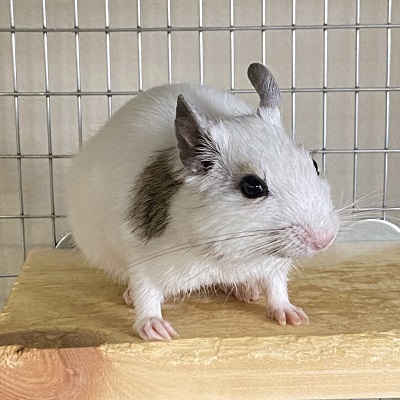
What a rainy month July 2023 turned out to be! We hope that you were able to spend time with us on Twitter @ExoticPetVets during the rainy days (and the sunny ones too!) as we featured the degu as our Animal of the Month for July. But if summertime activities got in the way and you missed some of our tweets, we have a summary for you right here that you can reference any time. Did you know?:
- Degus (Octodon degus) are small mammals and in the wild can be found in central Chile, living on the lower western slopes of the Andes mountains.
- The “octodon” part of the degu’s scientific name refers to their cheek teeth, which are in the shape of a figure-8. In Ancient Greek, octo (οκτώ) = eight and odous (ὀδούς) = tooth.
- Even though degus are not rats, they are sometimes called “brush-tailed rats” or “trumpet-tailed rats.”
- If you look at them quickly, it’s easy to confuse degus with gerbils as they do bear some resemblance to each other. But degus are larger than gerbils.
- Degus actually have more in common with chinchillas and guinea pigs – even though they look very different from each other.
- In scientific classification (taxonomy), degus, chinchillas and guinea pigs are all members of the class Mammalia and order Rodentia. They are also all of the suborder Hystricomorphs and parvorder Caviomorpha.
- Due to their intolerance of the thinner air found at higher elevations – along with the limitations of their habitat distribution – degus normally live at elevations below 1,200 metres.
- Degus in the wild live in balmy semi-arid shrublands that typically have rainy winters and dry summers. This Mediterranean-type of ecosystem is called “matorral” in Spanish.
- Degus are small mammals with stout bodies. From the tips of their noses to the tips of their tails, fully grown degus are around 30 cms in length (about 12 inches).
- Degus are mostly covered in yellowish-brown fur that is medium-to-dark in tone. The fur on their bellies is a lighter tan colour. They also have ring of lighter-coloured fur around their eyes.
- We mentioned earlier that degus are sometimes called “brush-tailed rats” or “trumpet-tailed rats.” That’s because of the tuft of black fur on the ends of their tails.
- Selective breeding has created different fur colour varieties seen in captive degus; including champagne, blue, black, chocolate and white.
- My what big ears you have! All the better for degus to hear you with.
- Compared with the overall size of their heads, degus have large ears that resemble the shape of butterfly wings. Their ears are darkly pigmented and are sparsely furred.
- Not only do degus have excellent hearing, but their large ears also allow them to dissipate heat and regulate their body temperature.
- Degus can’t sweat and can get heat stroke in temperatures in excess of 30 degrees Celsius (86 degrees F).
- What do degus and humans have in common? They both have similar circadian rhythms!
- Like humans, degus are generally considered to be diurnal – meaning they are awake during the day and asleep at night.
- And also like humans, degus can be different chronotypes. A chronotype is an animal’s natural preference of when they are active and when they like to sleep.
- This means some degus can be night owls and are more nocturnal in nature – and they adjust their sleep schedule accordingly.
- In addition, some degus can also be crepuscular; meaning, they are most active during the twilight hours of dusk and dawn.
- Because of these similarities, degus are commonly used as subjects for research into circadian rhythms and jet lag.
- Are orange teeth a good thing? Maybe not for humans, but for degus the answer is – absolutely!
- From birth, the enamel on the front surface of a degu’s incisors will start turning orange, which is believed to be a sign that the degu is eating well.
- If degus have pale incisors, it’s a sign that they aren’t getting proper nutrients.
- In the wild, degus will eat grasses, leaves, shoots, roots, some seeds from shrubs and occasionally fruit – although they are largely intolerant of sugar and are prone to diabetes.
- Degus have long tails, which are around 13 cms (5 inches) long. But degus should NEVER be picked up by the tail.
- As a defense mechanism, degus can “shed” their tails through a process known as “fur slip” or “tail slip.”
- Fur slip is the sloughing off of the fur and skin from their tails, allowing degus to escape from predators who have caught them by their tails.
- But once a degu tail is gone, it’s gone. It never grows back.
- In the wild, degu predators include birds of prey and the culpeo fox (Lycalopex culpaeus).
- Wild degus have an average lifespan of approximately 1-4 years. But in the absence of predators, a well cared-for degu in captivity can live an average of between 6-8 years.
We have featured degus as our Animal of the Month twice before. Check out our blog posts from September 2019 and March 2016 for more information on these charming rodents.

